



Kashmir’s famous Pashmina, a fine variant of spun cashmere — introduced to the valley by an Irani Sufi saint, Shah-e-Hamdan, and refined to a fine art form in the 16th century by the Mughals — has been under siege from several quarters.
The latest in its decades-long struggle to keep the craft heritage alive threatens to be the most serious: The fractious India and China standoff in Ladakh has made the traditional grazing lands of the Changthangi goats or Pashms, reared by the Changpa nomads, difficult to access.
 Changpa with their herds.
Changpa with their herds.
This is the newest of the several crises that Kashmir’s cashmere industry is struggling with. Today, the global cashmere trade is divided thus: 60 percent from Mongolia, another 30 percent from China and Russia, 9 percent from Afghanistan, Nepal and Central Asia, and barely about 1 percent from Kashmir.
While China and Russia each produce 750 tonnes of pashmina wool every year, and Mongolia dominates the world market with 1,000 tonnes, India produces a measly 45 tonnes.
And yet, in the global markets, handmade and hand-embroidered Kashmiri pashmina spun from feather-like wool and conferred with a GI stamp, is much sought after. Unlike other wool, the Changpa nomads do not shear their goats. Instead, in spring, the pashmina is brushed out with wooden combs, stored in the form of a loaf resembling candyfloss, and then spun into exquisite yarn.
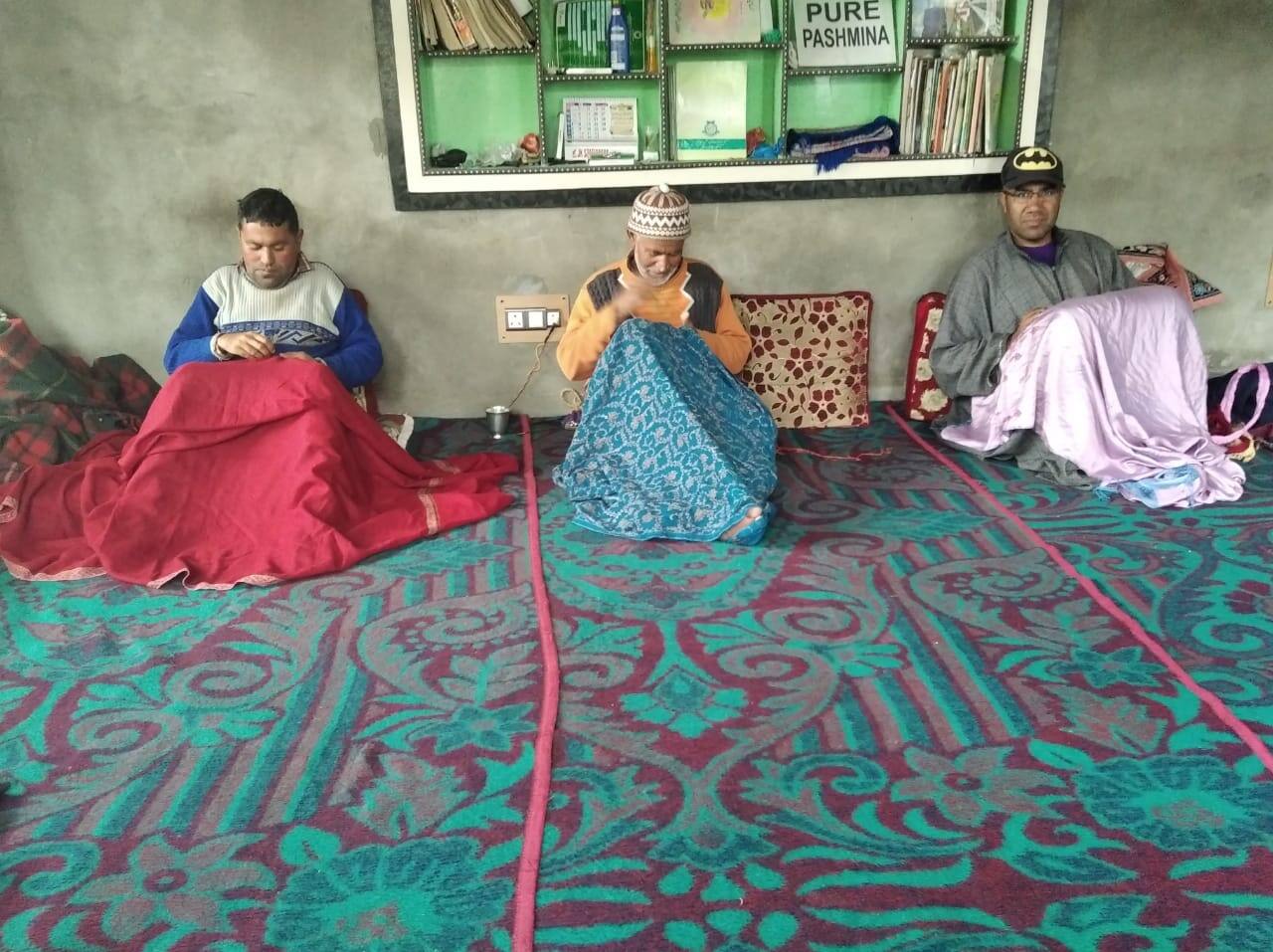 Kashmir Weavers.
Kashmir Weavers.
Eric Hansen, a London-based exporter of cashmere (he sells under the brand name, Cashmere Tales), says, “The thread produced by Kashmir’s spinners, who are largely women, is 12 to 16 microns in diameter, whereas the thread from the rest of the world is 17 to 20 microns. The Kashmiri cashmere scarves and shawls can sell for as much as $600 and $1000 in the world fashion capitals.”
The India-China standoff
Changpa nomads live in the cold Changthang region (or the northern meadows) of Ladakh, which straddles Tibet at over 5,000 metres above sea level. They rear the shaggy Changthangi goats, from whose lush undercoat or the pashm comes the pashmina wool. In spring, the pashm is harvested by the nomads and sold to the artisans in Kashmir, who spin it into yarn and then weave shawls from it, which are hand-embroidered with different kinds of embroideries such a Sozni and Tilla.
The Changthang region becomes inhospitable from November to February; temperatures can fall to - 50 degree Celsius. Before the onset of winters, the nomads begin descending to warmer grazing lands near the disputed border with China, along the Tibetan plateau, and across the frozen Indus River with their herds.
 Andraab.
Andraab.
Mubashir Andraabi, the man behind the exquisite luxury cashmere brand, Andraab, says that the gossamer Pashmina wool they produce is the result of the unique topography that the nomads and their herds traverse. “To maintain the quality of the under fleece, the nomadic lifestyle they live between extreme conditions and warmer grasslands is important.”
A way of life and a centuries-old process are now being threatened by the military stand-off.
 Andraab.
Andraab.
Artisan Tariq Mir, who through his family’s weaving business, Special Hands of Kashmir, works with 500 artisans and employs 40, frets, “Shor sharable se goats dar jaati hain. Weavers’ ke paas is waqt raw material nahi aa raha hai kyunki transport band hai (The noise of military movement hassles the goats. Also, the weavers have not been receiving raw materials because of the restriction on movement.”
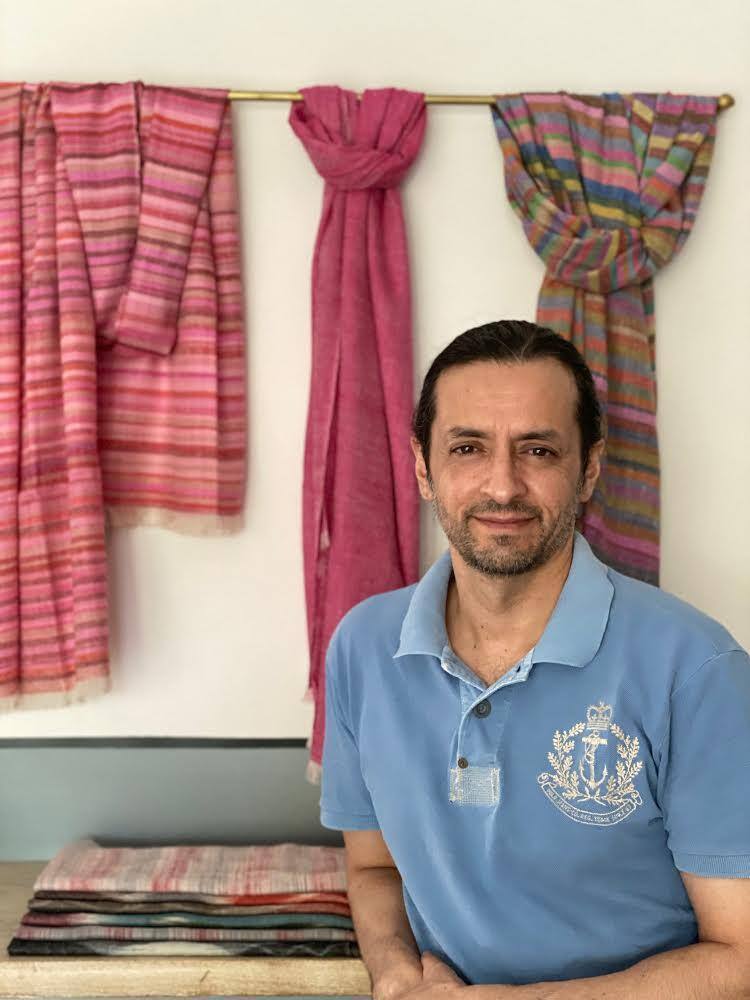 Mubashir Andrabi.
Mubashir Andrabi.
The nomads, who own an estimated 300,000 goats, as well as associations such as All Changtang Pashmina Growers Cooperative Marketing Society, are in talks with the local authorities and the Indian army to find a solution.
Over the last few years, the Ladakhis, with support from their local government, have worked hard to bring down the mortality of the young in the goatherds, from 40% a decade ago to as low as 10%, says veterinarian Dr Mohammed Deen, who heads the government goat farms project near Upshi in Changthang.
Sonam Changpa, a member of the Ladakh Pashm Association contends, “A lot of the routes have been barred by the Indian authorities, which is understandable. But without access to the warmer grazing grounds, a higher percentage of the young of the herds may not survive, which could lead to economic ruin for the nomads and hardships for the Kashmiri weavers. We may not see the drop in production right now; but in three years, when the young goats would have grown up to produce the Pashm, we will see a huge crunch.”
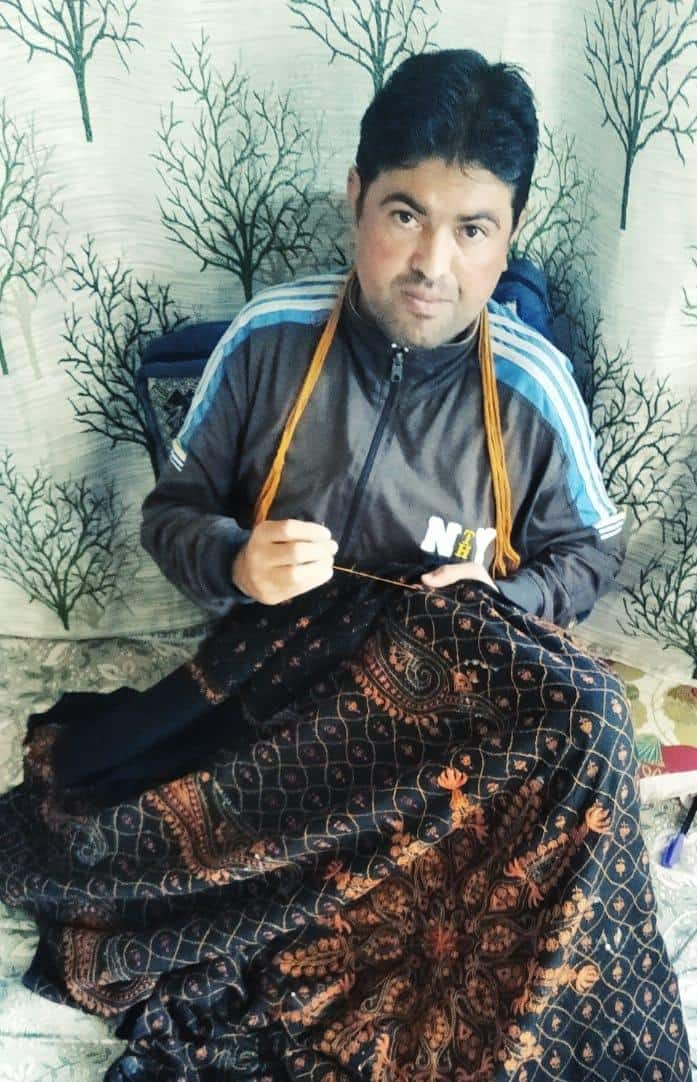 Tariq Mir.
Tariq Mir.
According to Andraabi, we will have to wait till the onset of winter in November-end to figure how bad the situation really is. “Maybe the authorities will come up with some plan to save the nomads and their herds. We hope they are allowed to bring their herds down for grazing,” he adds.
The stand-off may be recent, but the problems along the Tibetan plateau are age-old. Once, the nomads roamed the grasslands around the undemarcated borders of Tibet rather freely. “However, in recent years, our nomads have faced difficulty in accessing pastures in Tibet. Chinese soldiers have blocked them, while they bring herders from Tibet into our lands,” says Sonam Tsering, General Secretary of All Changtang Pashmina Growers Cooperative Marketing Society.
The local elders have been complaining to the Indian government about Chinese incursions for years. “No one took us seriously. Now, we are caught between the crossfire,” says Tsering.
Climate change hits the grasslands
The military stand-off apart, climate change — which have made winters a tad harsher and summer somewhat warmer — has been slowly decimating the traditional grasslands.
Asaf Ali, the co-founder of the contemporary brand, Kashmir Loom, says, there has been a steady rise in temperatures over the last few years and some of the greenery has been affected. “If the temperature rises by even 5 degree Celsius in the years to come, it will have serious consequences on the herds and the quality of the Pashmina wool. Already, Ladakh and Kashmir are dealing with landslides and extreme monsoon patterns.”
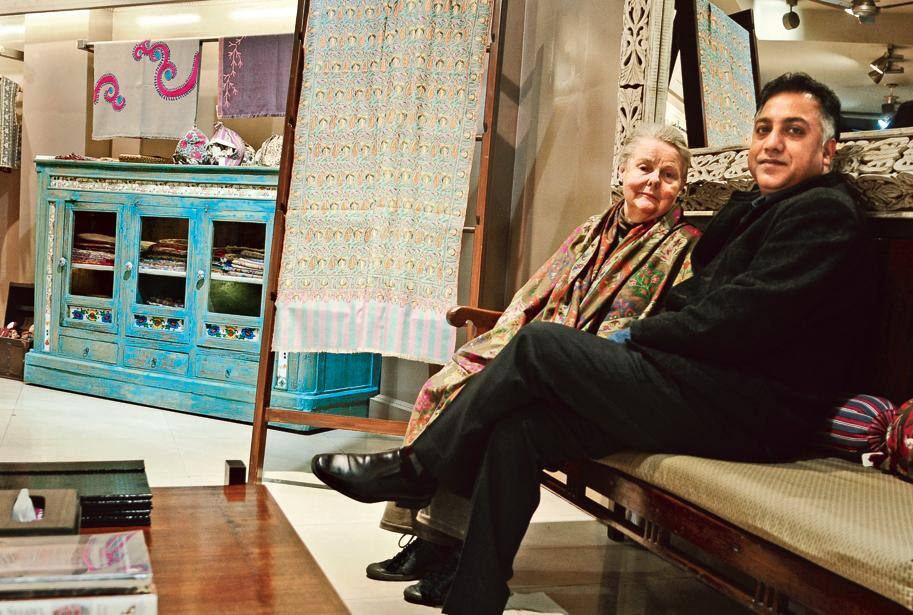 Asaf Ali and Jenny Housego, Kashmir Loom.
Asaf Ali and Jenny Housego, Kashmir Loom.
Over a relatively short period of five years, dozens of nomad families from the Changthang plateau have migrated away from their village, Kharnak, to the outskirts of Leh, 180 kilometres away, where they have set up their neighbourhood.
Targais Tashi, the village chieftain of Kharnak says over a barely audible phone call from Srinagar, where he is meeting artisans, "If weather patterns continue to change, it could have an irreversible impact on Pashmina goat-rearing on the Changthang. The younger generation would rather work in the city than continue this physically and emotionally exhausting work.”
 Changpa camp. Courtesy: Kashmir Loom.
Changpa camp. Courtesy: Kashmir Loom.
The Union Ministry of Textiles is attempting to reverse the trend by funding the Changpas to return to rearing goats on the plateau. The trade's decline will not just affect India’s best-known exports, but also end the unique culture of the Changpas.
About power looms and apathy of the young from the weaving communities
Kashmir’s fabled pashmina has, for years, been dealing with a worrying crisis on the weavers’ end, too.
The entire process of making a pashmina shawl— from dehairing, sorting, spinning and weaving to dying and embroidery—has been done manually for centuries. “Unfortunately, machines and power looms, which can produce eight to 10 shawls a day, are fast replacing traditional weaving looms, rendering a lot of artisans jobless,” says Jasir Ahmed, an artisan who runs a weaving and embroidery studio in Wakura, close to Srinagar.
He claims that till two years ago, power looms from Amritsar were harming their businesses. “Now, they have begun making their way into the Valley.” This, despite the ban on mechanisation to save the trade that was enforced under the 1985 Handloom Protection Act, claims Showkat Ahmad Mir, the former general secretary of the Union of Kashmir Pashmina Artisans (KPKU and the third generation pashmina weaver. “The government has failed to enforce the ban.”
Add to that the young in Kashmiri weavers families, who do not want to pursue their ancestor’s craft, given the frequent lockdowns and disturbances in the Valley, and the difficulty involved in weaving the pashmina.
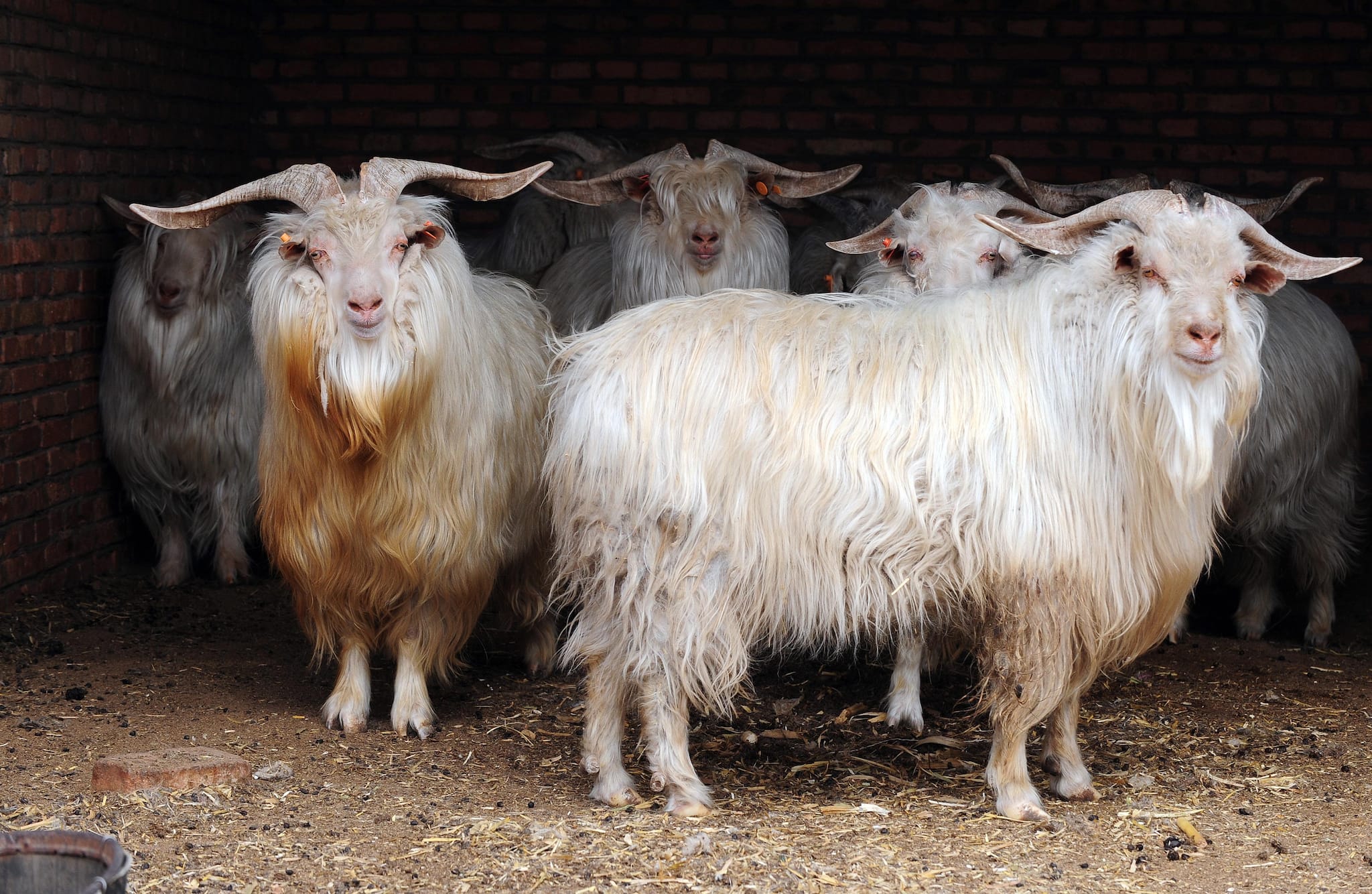
The needlework, the most exquisite of which can take years, has in the past cost the vision of many artisans. Nasir Ali (who works with 10 embroiders) talks about a 65-year-old pashmina shawl embroider who reportedly went blind. “He was working on a shawl with very dense work. It took him one-and-a-half years to complete it, but he lost his eyesight soon after.”
Jasir Ahmed claims that artisans, who put in a week or two spinning the pashmina yarn or even embroidering a shawl, may not earn more than Rs 300 to 400 a day. “The young find it far more lucrative to do some other work. The hold of middlemen is too strong. I had to fight my own family of embroiders to continue this tradition.”
Yet, artisans such as Mir and Ahmed are working towards contemporizing the pashmina tradition for a younger generation. “We have been blending pashmina and khadi for markets in the south of India. We make silk cushion covers and silk sarees embroidered with the pashmina yarn, which are popular. We have also transformed the traditional shawl patterns and now use a lot of geometric designs or animals motifs,” says Mir. Ahmed produces beautiful Pashmina sarees and dupattas with the rare Tilla embroidery.
The COVID effect
The fall in export orders and the slowing domestic demand have hit home hard. Ali says, “The weavers in the valley have very little work. Many weavers depend on exhibitions and shows, which are not possible at the moment. We are surviving because of some export orders and social media, which are pushing sales.” Andraabi adds that pashmina sales are often driven by the tourists’ arrival in the valley. The abrogation of Article 370, intermittent curfews, and now
COVID has destroyed the tourism market in Kashmir, affecting the business of Pashmina.
 Dorukha Cashmere Shawl from Kashmir Loom.
Dorukha Cashmere Shawl from Kashmir Loom.
Yet, there is hope. “Pashmina is recognised as one of India’s tangible heritage,” he muses Andraabi. “For 600 years, the pashmina made in Kashmir has been coveted by the royalty and the elite down centuries. The sway of beautiful handmade Kashmiri pashmina will persist.”
Deepali Nandwani is a journalist who keeps a close watch on the world of luxury.
Discover the latest Business News, Sensex, and Nifty updates. Obtain Personal Finance insights, tax queries, and expert opinions on Moneycontrol or download the Moneycontrol App to stay updated!
Find the best of Al News in one place, specially curated for you every weekend.
Stay on top of the latest tech trends and biggest startup news.